Within various Medieval literature detailing history and folklore throughout Europe, one who looks hard enough won’t have to struggle to find references to hairy, manlike beasts, variously referred to as orcs, ogres, trolls, woodwoses, and wild men in various documents from England and its surrounding countries.
The Konungs skuggsj




While this source is authentic, it is difficult to find any tradition generally of Irish wildmen. An exception might be the gruagach. This word is variously translated as “giant, ogre, magician” and may be derived from the Irish word gruaig, ‘hair’. They turn up in folk stories, but not usually in accounts of encounters. (They shopuld not be confused with the female long-haired gruagach of Scottish folklore; but the Irish-type gruagach turns up in Scottish folklore also.